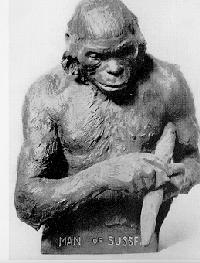So far, the all-time hoax longevity record goes to the famous Piltdown Man deception, which launched in 1912 and wasn’t “found out” until 1953.
It’s a terrific story.
On December 18, 1912, Charles Dawson and Arthur Smith Woodward presented the remains of an early human fossil to the Geological Society of London and, for all intents and purposes, the world.
They said the reassembled skull and jawbone fragments had been found in a gravel pit near the village of Piltdown in the County of Sussex. Thus, the “Piltdown Man” moniker.
At a time when human evolution was a relatively new idea, the find was earthshattering. And the discovery in England of the earliest known human fossil also confirmed the authority of an expanding British Empire.
Piltdown Man’s authenticity was questioned by skeptics from the get-go. But that didn’t stop the public and most of the scientific community from accepting it uncritically.
In fact, a memorial marking the site of the Piltdown discovery was even unveiled in July 1938. You can still visit it at Barkham Manor, Piltdown.
Anyway, in 1953, Piltdown Man was exposed as a fake. Its mandible wasn’t human but came instead from an orangutan. The molars and canine tooth associated with it had been artificially filed. The hinge had been broken to prevent exposure of the mandible’s incompatibility with the skull.
Ashes to ashes, as they say…
So who pulled off this infamous hoax of four decades?
Suspects are many. Charles Dawson is one, of course. Others include Pierre Teilhard de Chardin, Arthur Keith, Martin A. C. Hinton, and Horace de Vere Cole.
My favorite suspect is Arthur Conan Doyle, the creator of Sherlock Holmes. The same year as the Piltdown “discovery,” Doyle had maybe-not-so-coincidentally published his novel The Lost World, a tale of exploration in a hidden prehistoric land.
But does it really matter who was behind the fossil forgery?
I think what matters is that it was a tremendous, long-successful feat of subterfuge.
Sure, it was underhanded. And it might have set back evolutionary research for a half-century.
But you’ve gotta admit it was brilliantly conceived and orchestrated.
It captured imaginations.
It was convincing.
People bought it.
Can the same be said for whatever product or service you’re selling?
I’m not suggesting you commit fraud or lie to your customers.
But I do recommend that you find inspiration in the incredible marketing strategy that sold the Piltdown hoax.
Go forth, find your own “Piltdown Man,” and sell the hell out of it!




